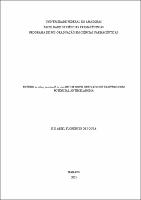| ???jsp.display-item.social.title??? |


|
Please use this identifier to cite or link to this item:
https://tede.ufam.edu.br/handle/tede/10988| ???metadata.dc.type???: | Dissertação |
| Title: | Estudo in silico, in vitro e in vivo de um novo derivado de xanteno com potencial antimelanoma |
| ???metadata.dc.creator???: | Sousa, Isis Ariel Florêncio de  |
| ???metadata.dc.contributor.advisor1???: | Ameida, Patrícia Danielle Oliveira de |
| First advisor-co: | Holanda, Keyla Emanuelle Ramos de |
| ???metadata.dc.contributor.referee1???: | Oliveira, Stéfani Ferreira de |
| ???metadata.dc.contributor.referee2???: | Mendonça, Leilane de Sousa |
| ???metadata.dc.description.resumo???: | O melanoma é a forma mais agressiva e letal do câncer de pele, caracterizado por processos metastáticos, e apesar dos avanços terapêuticos, como a terapia direcionada e a imunoterapia, ainda existem desafios relacionados à resistência aos tratamentos. Estudos recentes sugerem que derivados de xanteno podem ser novas opções terapêuticas promissoras para o melanoma, devido à sua estrutura que permite a incorporação de grupamentos químicos capazes de desencadear atividades terapêuticas. Este estudo teve como objetivo avaliar o potencial antimelanoma de um novo derivado de xanteno, o PD01, por meio de abordagens in silico, in vitro e in vivo. A triagem virtual foi realizada utilizando técnicas de docking molecular para avaliar a afinidade de interação entre o composto PD01 e o medicamento de referência vemurafenib. Os parâmetros farmacocinéticos do PD01 foram analisados por meio da plataforma SwissADME. A caracterização físico-química do PD01 foi realizada com Ressonância Magnética Nuclear (RMN) e espectrofotometria de absorção no Infravermelho (IV). Ensaios de Termogravimetria (TGA) e Calorimetria Exploratória Diferencial (DSC) foram realizados para investigar a estabilidade térmica do PD01. Nos ensaios in vitro, foram utilizadas em três linhagens celulares: melanoma humano (SK-MEL-28), melanoma murino (B16-F10) e fibroblasto humano (MRC-5) e a citotoxicidade foi avaliada pelo método de Alamar Blue. A morfologia celular foi analisada por coloração com kit panótico rápido, e o tipo de morte foi verificada pela coloração diferencial com acridina orange e brometo de etídio. O composto PD01 foi testado em um modelo in vivo de melanoma murino, e comparado com o controle positivo (doxorrubicina) para avaliação da inibição do crescimento tumoral. A análise histológica foi realizada para verificar o comprometimento dos órgãos. Na triagem virtual, o PD01 apresentou melhor afinidade de interação (-11,1 kcal/mol) quando comparado com o medicamento de referência, Vemurafenib (-9,204 kcal/mol), além de indicar um perfil de lipofilicidade. As análises de RMN e espectrofotometria IV indicaram que o PD01 possui uma estrutura molecular definida. Os ensaios TGA e DSC mostraram uma perda de massa de 57,72% entre 26 e 600 ºC, com picos observados a 60,2 ºC e 299,47 ºC. A molécula foi citotóxica, com valores de CI50 para SK-MEL-28 de 5,07 ± 1,28 μM, B16-F10 de 18,85 ± 3,28 μM e MRC-5 de 4,94 ± 0,72 μM. As análises morfológicas revelaram que o PD01 induziu morte celular por apoptose, com células em apoptose e necrose observadas, especialmente com a concentração de 10 μM. No modelo in vivo de melanoma murino, o PD01 foi menos eficaz que a doxorrubicina, com inibição do crescimento tumoral de 5,96% e 10,16% nas doses de 3 mg e 30 mg, respectivamente, enquanto a doxorrubicina obteve 29,49%. A histologia dos órgãos não mostrou comprometimento significativo, sugerindo que o PD01, com doses otimizadas, poderia apresentar melhores resultados terapêuticos. Em conclusão, o derivado de xanteno PD01 apresentou atividade citotóxica contra células de melanoma, induzindo apoptose, com resultados promissores em estudos iniciais. No entanto, a sua eficácia em modelos in vivo foi inferior aos tratamentos convencionais. Futuros estudos devem melhorar sua formulação, solubilidade e biodisponibilidade para potencializar seus efeitos terapêuticos e possibilitar ensaios clínicos. |
| Abstract: | Melanoma is the most aggressive and lethal form of skin cancer, characterized by metastatic processes. Despite therapeutic advancements, such as targeted therapy and immunotherapy, challenges related to treatment resistance persist. Recent studies suggest that xanthene derivatives may represent promising therapeutic options for melanoma due to their structure, which allows the incorporation of chemical groups capable of triggering therapeutic activities. This study aimed to evaluate the antimelanoma potential of a novel xanthene derivative, PD01, using in silico, in vitro, and in vivo approaches. Virtual screening was performed using molecular docking techniques to assess the interaction affinity between PD01 and the reference drug vemurafenib. The pharmacokinetic parameters of PD01 were analyzed through the SwissADME platform. The physicochemical characterization of PD01 was conducted using Nuclear Magnetic Resonance (NMR) and Infrared (IR) absorption spectrophotometry. Thermogravimetric (TGA) and Differential Scanning Calorimetry (DSC) assays were performed to investigate the thermal stability of PD01. In vitro assays were conducted on three cell lines: human melanoma (SK-MEL-28), murine melanoma (B16-F10), and human fibroblasts (MRC-5), with cytotoxicity evaluated by the Alamar Blue method. Cell morphology was analyzed using a rapid panotic staining kit, and the type of cell death was assessed by differential staining with acridine orange and ethidium bromide. PD01 was tested in a murine melanoma in vivo model and compared to the positive control (doxorubicin) for tumor growth inhibition evaluation. Histological analysis was performed to assess organ integrity. In the virtual screening, PD01 showed better interaction affinity (-11.1 kcal/mol) compared to the reference drug vemurafenib (-9.204 kcal/mol), also indicating a lipophilic profile. NMR and IR spectrophotometry analyses revealed that PD01 possesses a defined molecular structure. TGA and DSC assays showed a mass loss of 57.72% between 26 and 600 ºC, with peaks observed at 60.2 ºC and 299.47 ºC. The molecule was cytotoxic, with IC50 values of 5.07 ± 1.28 μM for SK-MEL-28, 18.85 ± 3.28 μM for B16-F10, and 4.94 ± 0.72 μM for MRC-5. Morphological analyses revealed that PD01 induced cell death through apoptosis, with apoptotic and necrotic cells observed, particularly at the 10 μM concentration. In the murine melanoma in vivo model, PD01 was less effective than doxorubicin, with tumor growth inhibition of 5.96% and 10.16% at doses of 3 mg and 30 mg, respectively, while doxorubicin achieved 29.49%. Histology of the organs did not show significant damage, suggesting that PD01, with optimized doses, could yield better therapeutic outcomes. In conclusion, the xanthene derivative PD01 exhibited cytotoxic activity against melanoma cells, inducing apoptosis, with promising results in preliminary studies. However, its efficacy in in vivo models was inferior to conventional treatments. Future studies should improve its formulation, solubility, and bioavailability to enhance its therapeutic effects and facilitate clinical trials. |
| Keywords: | Melanoma Neoplasias cutâneas Xantenos |
| ???metadata.dc.subject.cnpq???: | CIENCIAS DA SAUDE: FARMACIA: ANALISE TOXICOLOGICA |
| ???metadata.dc.subject.user???: | Xanteno Caracterização físico-química Citotoxicidade Melanoma |
| Language: | por |
| ???metadata.dc.publisher.country???: | Brasil |
| Publisher: | Universidade Federal do Amazonas |
| ???metadata.dc.publisher.initials???: | UFAM |
| ???metadata.dc.publisher.department???: | Faculdade de Ciências Farmacêuticas |
| ???metadata.dc.publisher.program???: | Programa de Pós-graduação em Ciências Farmacêuticas |
| Citation: | SOUSA, Isis Ariel Florêncio de. Estudo in silico, in vitro e in vivo de um novo derivado de xanteno com potencial antimelanoma. 2025. 75 f. Dissertação (Mestrado em Ciências Farmacêuticas) - Universidade Federal do Amazonas, Manaus, 2024. |
| ???metadata.dc.rights???: | Acesso Aberto |
| ???metadata.dc.rights.uri???: | https://creativecommons.org/licenses/by-nc-nd/4.0/ |
| URI: | https://tede.ufam.edu.br/handle/tede/10988 |
| Issue Date: | 29-Nov-2024 |
| Appears in Collections: | Mestrado em Ciências Farmacêuticas |
Files in This Item:
| File | Description | Size | Format | |
|---|---|---|---|---|
| DISS_IsisSousa_PPGCF.pdf | 3.5 MB | Adobe PDF |  Download/Open Preview |
Items in DSpace are protected by copyright, with all rights reserved, unless otherwise indicated.




